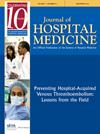我们做的事情没有理由™:动脉血气测试筛选高碳呼吸衰竭。
IF 2.3
4区 医学
Q1 MEDICINE, GENERAL & INTERNAL
引用次数: 0
摘要
静脉血气 (VBG) 可以安全有效地筛查高碳酸血症呼吸衰竭。多项研究证实,PvCO2 小于 45 的 VBG 能可靠地排除高碳酸血症。当怀疑出现高碳酸血症呼吸衰竭时,使用 VBG 初步筛查高碳酸血症可减少动脉血气的总体使用量,因为动脉血气会给患者带来更多痛苦,并需要更多时间和专业知识来完成。本文章由计算机程序翻译,如有差异,请以英文原文为准。




Things We Do for No Reason™: Arterial blood gas testing to screen for hypercarbic respiratory failure
Venous blood gases (VBGs) are safe and effective at screening for hypercarbic respiratory failure. Multiple studies have validated that a VBG with a PvCO2 less than 45 reliably rules out hypercarbia. The use of VBGs for the initial screening of hypercarbia when hypercarbic respiratory failure is suspected can reduce the overall use of arterial blood gases which are more painful and take more time and expertise to perform.
求助全文
通过发布文献求助,成功后即可免费获取论文全文。
去求助
来源期刊

Journal of hospital medicine
医学-医学:内科
CiteScore
4.40
自引率
11.50%
发文量
233
审稿时长
4-8 weeks
期刊介绍:
JHM is a peer-reviewed publication of the Society of Hospital Medicine and is published 12 times per year. JHM publishes manuscripts that address the care of hospitalized adults or children.
Broad areas of interest include (1) Treatments for common inpatient conditions; (2) Approaches to improving perioperative care; (3) Improving care for hospitalized patients with geriatric or pediatric vulnerabilities (such as mobility problems, or those with complex longitudinal care); (4) Evaluation of innovative healthcare delivery or educational models; (5) Approaches to improving the quality, safety, and value of healthcare across the acute- and postacute-continuum of care; and (6) Evaluation of policy and payment changes that affect hospital and postacute care.
 求助内容:
求助内容: 应助结果提醒方式:
应助结果提醒方式:


